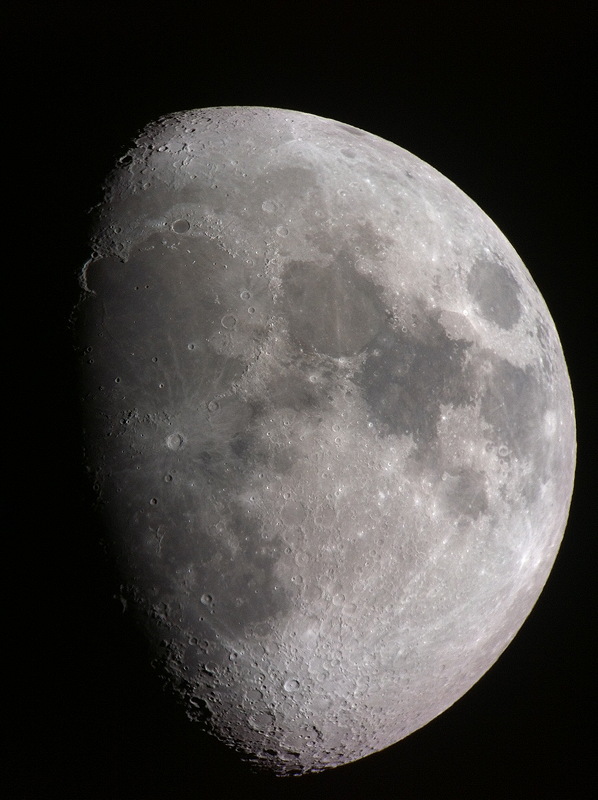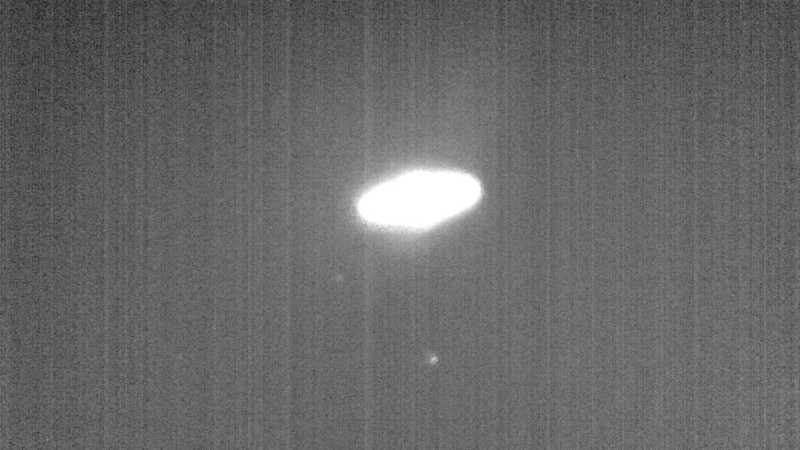
Saturn and Some Moons with iPhone 4
Posted: 21 April 2013
Cassiopeia Observatory was opened on Saturday, 20 April 2013, at 2130 MST, 63°F. Due to another commitment I was late once again opening the observatory this night. There were a few clouds very low in the southern sky. At 2138 MST, viewed the waxing gibbous moon using 2" wide angle eyepieces at 83X and 222X. The seeing was fairly good. The lunar terminator views were super in places. At 2151 MST, went to Saturn and viewed it at 222X. It was too low for good seeing. Went back to the moon. Initially I was going to use the D7000 DSLR for lunar imaging but I changed my mind and used the iPhone 4 instead. This is an afocal image, 77X, MX-1 afocal adapter, 8" LX200-ACF:

At 2215 MST, returned to Saturn and did a series of iPhone afocal video recordings at various magnifications, with and without a moon filter. The iOS apps used were Camera and FiLMiC Pro. FiLMiC Pro, with locked focus and exposure, was used for all the stacked images shown in this report. At 77X plus the moon filter, Saturn was overexposed. At 154X + moon filter, Saturn was not overexposed, and a stack (using Keith's Image Stacker) of 1102 frames yielded this image:

At 154X without the moon filter, Saturn was overexposed. On the previous session I learned that Saturn would overexpose at 222X without the moon filter, so this image is at 222X + moon filter and a stack of 1105 frames:

Using 444X + moon filter, Saturn was too underexposed to be usable. However, 444X without the moon filter was OK. This is a stack of 1096 frames:

I then did some afocal imaging at 444X (no moon filter) to try to capture some of Saturn's moons with the iPhone. This SkySafari Pro 3 screen capture on the iPhone shows many of the moons:

This image captured with the iOS Camera app shows Titan and Rhea (faintly):

This image captured using the iOS app Night Modes shows Titan, Rhea, Dione (faintly), and Tethys (faintly):

Using True NightVision, the moons Titan, Rhea, Dione, and Tethys are all easily seen in these desaturated images using the Fast Action mode (top) and Norm mode (bottom):


I completed imaging at 2315 MST and did more Saturn observing using the 2" 9mm 100° eyepiece (222X). Seeing was much better now than it was when I first observed Saturn this night. With the assistance of SkySafari Pro on the iPhone:


I was able to easily locate Titan, Dione, Rhea, Tethys, and Iapetus. I switched to a 1.25" 5.5mm eyepiece (364X) and tried for Enceladus, but couldn't see it.
At 2331 MST, did some lunar terminator observing at 364X. The views of some mountain shadows were incredible.
At 2346 MST, returned to Saturn and with the 2" 24mm Ultra Wide-Angle eyepiece (83X) located Enceladus, making this a six Saturn moon night with the 8" telescope!
At 2350 MST, viewed M57, the Ring Nebula, with the 2" 24mm UWA eyepiece (83X). Wow! Even with the bright sky background due to the moon, the view of the Ring was very good. Then viewed M13, the Great Globular Cluster in Hercules, with the 2" 24mm eyepiece. Super view. I am looking forward to viewing both DSOs in a dark sky using my new 2" 24mm UWA eyepiece.
Closed the observatory at 0008 MST, 61°F.
Comments are welcome; use the Comments section below, or you can Email Me. Thanks.
Cassiopeia Observatory Home Page